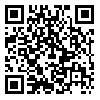Volume 16, Issue 1 (Vol.16, No.1 2020)
irje 2020, 16(1): 81-89 |
Back to browse issues page
Download citation:
BibTeX | RIS | EndNote | Medlars | ProCite | Reference Manager | RefWorks
Send citation to:



BibTeX | RIS | EndNote | Medlars | ProCite | Reference Manager | RefWorks
Send citation to:
Karami M, Rahmani K, Moradi G, Gouya M, Sabouri A, Entezar Mahdi K, et al . Measles Surveillance System in the Islamic Republic of Iran: History, Structures and Achievements. irje 2020; 16 (1) :81-89
URL: http://irje.tums.ac.ir/article-1-6527-en.html
URL: http://irje.tums.ac.ir/article-1-6527-en.html
M Karami1 
 , KH Rahmani2
, KH Rahmani2 
 , GH Moradi3
, GH Moradi3 
 , MM Gouya4
, MM Gouya4 
 , A Sabouri5
, A Sabouri5 
 , K Entezar Mahdi6
, K Entezar Mahdi6 
 , GH Kamali7
, GH Kamali7 
 , SM Zahraei *
, SM Zahraei * 
 8
8

 , KH Rahmani2
, KH Rahmani2 
 , GH Moradi3
, GH Moradi3 
 , MM Gouya4
, MM Gouya4 
 , A Sabouri5
, A Sabouri5 
 , K Entezar Mahdi6
, K Entezar Mahdi6 
 , GH Kamali7
, GH Kamali7 
 , SM Zahraei *
, SM Zahraei * 
 8
8
1- Associate Professor of Epidemiology, Social Determinant of Heath Research Center, Hamadan University of Medical Sciences, Hamadan, Iran
2- Assistant Professor of Epidemiology, Social Determinants of Health Research Center, Research Institute for Health Development, Kurdistan University of Medical Sciences, Sanandaj, Iran
3- Associate Professor of Epidemiology, Social Determinants of Health Research Center, Research Institute for Health Development, Kurdistan University of Medical Sciences, Sanandaj, Iran
4- Associate Professor of Infectious Diseases, Centre for Communicable Diseases Control, Ministry of Health and Medical Education, Tehran, Iran
5- MSc in public Health, Centre for Communicable Diseases Control, Ministry of Health and Medical Education, Tehran, Iran
6- MSc Student in Epidemiology, Social Determinants of Health Research Center, Research Institute for Health Development, Kurdistan University of Medical Sciences, Sanandaj, Iran
7- Associate Professor of Ophtalmology, School of Medicine, Kurdistan University of Medical Sciences, Sanandaj, Iran
8- Associate Professor of Infectious Diseases, Centre for Communicable Diseases Control, Ministry of Health and Medical Education, Tehran, Iran ,m-zahraei@health.gov.ir
2- Assistant Professor of Epidemiology, Social Determinants of Health Research Center, Research Institute for Health Development, Kurdistan University of Medical Sciences, Sanandaj, Iran
3- Associate Professor of Epidemiology, Social Determinants of Health Research Center, Research Institute for Health Development, Kurdistan University of Medical Sciences, Sanandaj, Iran
4- Associate Professor of Infectious Diseases, Centre for Communicable Diseases Control, Ministry of Health and Medical Education, Tehran, Iran
5- MSc in public Health, Centre for Communicable Diseases Control, Ministry of Health and Medical Education, Tehran, Iran
6- MSc Student in Epidemiology, Social Determinants of Health Research Center, Research Institute for Health Development, Kurdistan University of Medical Sciences, Sanandaj, Iran
7- Associate Professor of Ophtalmology, School of Medicine, Kurdistan University of Medical Sciences, Sanandaj, Iran
8- Associate Professor of Infectious Diseases, Centre for Communicable Diseases Control, Ministry of Health and Medical Education, Tehran, Iran ,
Abstract: (3245 Views)
Background and Objectives: Elimination and eradication of measles requires designing and implementing an enhanced surveillance system. The purpose of this study was to review the measles surveillance system in Iran.
Methods: The data of this study were obtained from the surveillance system of the Center for Communicable Disease Control; a review of the records, documents, books, and published articles; and interviews with process owners and experts of measles surveillance in 2017-2019.
Results: Iran has a surveillance plan to eliminate the measles. The current design for suspected cases of measles in Iran is a case-based surveillance system, in which for each identified case with fever and maculopapular rashes, some activities such reporting, laboratory confirmation, clinical and epidemiological investigation and case registration in individual forms are done.
Conclusion: Complete surveillance of cases suspicious of measles and high coverage of vaccination in children less than 2 years in a cohesive surveillance system and rapid response to the outbreak have led to lack of occurrence of indigenous measles in Iran. Although the current status of the measles surveillance system in Iran seems to be favorable, since Iran is at the stage of measles elimination, it is essential to increase the sensitivity of the reporting system for suspected cases of measles and to maintain the status of vaccine coverage to save elimination status.
Methods: The data of this study were obtained from the surveillance system of the Center for Communicable Disease Control; a review of the records, documents, books, and published articles; and interviews with process owners and experts of measles surveillance in 2017-2019.
Results: Iran has a surveillance plan to eliminate the measles. The current design for suspected cases of measles in Iran is a case-based surveillance system, in which for each identified case with fever and maculopapular rashes, some activities such reporting, laboratory confirmation, clinical and epidemiological investigation and case registration in individual forms are done.
Conclusion: Complete surveillance of cases suspicious of measles and high coverage of vaccination in children less than 2 years in a cohesive surveillance system and rapid response to the outbreak have led to lack of occurrence of indigenous measles in Iran. Although the current status of the measles surveillance system in Iran seems to be favorable, since Iran is at the stage of measles elimination, it is essential to increase the sensitivity of the reporting system for suspected cases of measles and to maintain the status of vaccine coverage to save elimination status.
Type of Study: Research |
Subject:
Epidemiology
Received: 2020/06/29 | Accepted: 2020/06/29 | Published: 2020/06/29
Received: 2020/06/29 | Accepted: 2020/06/29 | Published: 2020/06/29
Send email to the article author
| Rights and permissions | |
 |
This work is licensed under a Creative Commons Attribution-NonCommercial 4.0 International License. |



